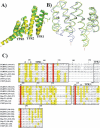Crystallographic structure of the tetratricopeptide repeat domain of Plasmodium falciparum FKBP35 and its molecular interaction with Hsp90 C-terminal pentapeptide
- PMID: 19691130
- PMCID: PMC2786975
- DOI: 10.1002/pro.226
Crystallographic structure of the tetratricopeptide repeat domain of Plasmodium falciparum FKBP35 and its molecular interaction with Hsp90 C-terminal pentapeptide
Abstract
Plasmodium falciparum FK506-binding protein 35 (PfFKBP35) that binds to FK506 contains a conserved tetratricopeptide repeat (TPR) domain. Several known TPR domains such as Hop, PPP5, CHIP, and FKBP52 are structurally conserved and are able to interact with molecular chaperones such as Hsp70/Hsp90. Here, we present the crystal structure of PfFKBP35-TPR and demonstrate its interaction with Hsp90 C-terminal pentapeptide (MEEVD) by surface plasmon resonance and nuclear magnetic resonance spectroscopy-based binding studies. Our sequence and structural analyses reveal that PfFKBP35 is similar to Hop and PPP5 in possessing all the conserved residues which are important for carboxylate clamping with Hsp90. Mutational studies were carried out on positively charged clamp residues that are crucial for binding to carboxylate groups of aspartate, showing that all the mutated residues are important for Hsp90 binding. Molecular docking and electrostatic calculations demonstrated that the MEEVD peptide of Hsp90 can form aspartate clamp unlike FKBP52. Our results provide insightful information and structural basis about the molecular interaction between PfFKBP35-TPR and Hsp90.
Figures






References
-
- World Health Organization. 2005. World Malaria Report.
-
- Hyde JE. Mechanisms of resistance of Plasmodium falciparum to antimalarial drugs. Microbes Infect. 2002;4:165–174. - PubMed
-
- Bell A, Wernli B, Franklin RM. Roles of peptidyl-prolyl cis-trans isomerase and calcineurin in the mechanisms of antimalarial action of cyclosporin A, FK506, and rapamycin. Biochem Pharmacol. 1994;48:495–503. - PubMed
-
- Kumar R, Adams B, Musiyenko A, Shulyayeva O, Barik S. The FK506-binding protein of the malaria parasite, Plasmodium falciparum, is a FK506-sensitive chaperone with FK506-independent calcineurin-inhibitory activity. Mol Biochem Parasitol. 2005;141:163–173. - PubMed
-
- Monaghan P, Bell A. A Plasmodium falciparum FK506-binding protein (FKBP) with peptidyl-prolyl cis-trans isomerase and chaperone activities. Mol Biochem Parasitol. 2005;139:185–195. - PubMed
Publication types
MeSH terms
Substances
LinkOut - more resources
Full Text Sources
Miscellaneous

